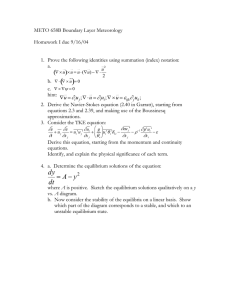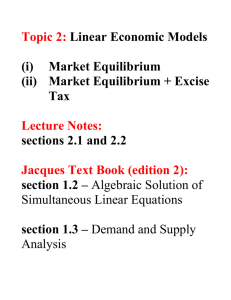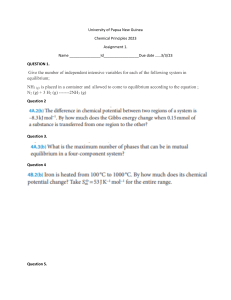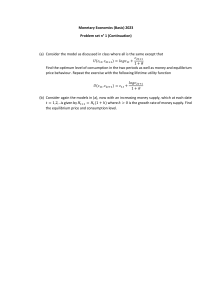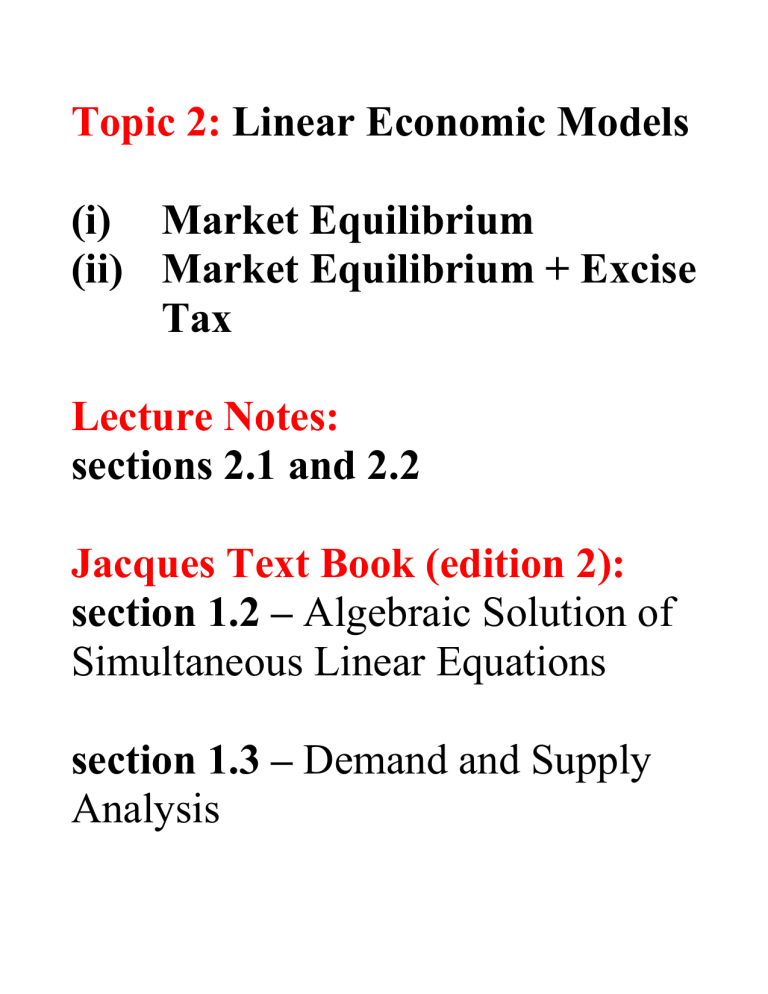
Topic 2: Linear Economic Models (i) Market Equilibrium (ii) Market Equilibrium + Excise Tax Lecture Notes: sections 2.1 and 2.2 Jacques Text Book (edition 2): section 1.2 – Algebraic Solution of Simultaneous Linear Equations section 1.3 – Demand and Supply Analysis ASIDE: Solving Simultaneous Equations Ö Plot on a graph and then solve to find common co-ordinates…… OR Ö Solve Algebraically Eg. 4x + 3y = 11 2x + y = 5 eq.1 eq.2 1. Express both eq. in terms of the same value of x (or y) 4x = 11 - 3y eq.1 4x = 10 - 2y eq.2’ 2. Substitute value of eq.1 into eq.2’ Ö 11 - 3y = 10 - 2y 3. collect terms Ö 11 – 10 = -2y + 3y Ö1=y 4. now compute x Ö 4x = 10 - 2y Ö 4x = 10 – 2 = 8 Öx=2 5. check the solution Ö in both equations, when x = 2, y = 1 Ö the two lines intersect at (2,1) 4x+3y-11 15 2x+y=5 10 Y 5 -3 0 -2 -1 0 1 2 -5 -10 X 3 4 5 6 7 Note that if the two functions do not intersect, then cannot solve equations simultaneously….. x – 2y = 1 2x – 4y = -3 Step 1 2x = 2 + 4y 2x = -3 + 4y Step 2 2 + 4y = -3 + 4y 2+3 = 0………… eq.1 eq.2 eq.1’ eq.2 BUT => No Solution to the System of Equations Solving Linear Economic Models Market Equilibrium Quantity Demanded = Quantity Supplied Finding the equilibrium quantity levels….. price and In general, Demand Function: QD = a + bP Supply Function: QS = c + dP • Set QD = QS and solve simultaneously for Pe = (a - c)/(d - b) • Knowing Pe, find Qe given the demand/supply functions • Qe = (ad - bc)/(d - b) Eg.1 QD = 50 – P QS = 20 + 2P (i) (ii) Ö Set QD = QS 50 – P = 20 + 2P 3P = 30 P = 10 Ö Knowing P, find Q Q = 50 – P = 50 - 10 = 40 Ö Check the solution i) 40 = 50 – 10 and (ii) 40 =20 + (2*10) In both equations if P=10 then Q=40 Changes in Demand or Supply… Shift the curves and results in a new equilibrium price and quantity Section 2.2 Notes: Market Equilibrium + Excise Tax Impose a tax t on suppliers per unit sold…… Shifts the supply curve to the left QD = a + bP QS = d + eP with no tax QS = d + e(P-t) with tax t on suppliers QD = 50 – P, and QS = 20 + 2P becomes QS = 20 + 2(P-t) Write Equilibrium P and Q as functions of t Ö Set QD = QS Consumer Price 50 – P = 20 + 2(P-t) 30 = 3P - 2t 3P = 30 + 2t P = 10 + 2/3t Ö Knowing P, find Q Q = 50 – P = 50 – (10+2/3t) = 40 – 2/3t Comparative Statics: effect on P and Q of ↑t (i) As ↑ t, then ↑ P paid by consumers by 2 /3t ⇒ remaining tax (1/3) is paid by suppliers total tax t Consumers pay = 2/3t + 1/3t Suppliers pay Price consumers pay – price suppliers receive = total tax t e.g. t = £3 Consumer P: £12 (pre-tax eq. p + 2/3t) 1 Supplier P: £9 (pre-tax eq. p – /3t) (ii) and ↓ Q by 2/3t, reflecting a shift to the left of the supply curve Another Tax Problem…. QD = 132 – 8P QS = 6 + 4P (i) Find the equilibrium P and Q. (ii) How does a per unit tax t affect outcomes? (iii) What is the equilibrium P and Q if unit tax t = 4.5? Solution….. (i) Equilibrium values Ö Set QD = QS 132 – 8P = 6 +4P 12P = 126 P = 10.5 Ö Knowing P, find Q Q = 6 +4P = 6 + 4(10.5) = 48 Equilibrium values: P = 10.5 and Q=48 (ii) The comparative Statics of adding a tax…… QD = 132 – 8P QS = 6 + 4(P – t) Ö Set QD = QS 132 – 8P = 6 +4(P – t) 12P = 126 +4t P = 10.5 +1/3 t Ö Knowing P, find Q Q = 6 +4[P-t] = 6 + 4[(10.5+1/3 t) – t] 8 = 48 - /3 t Imposing t => ↑ consumer P by /3t, 2 8 supplier pays /3t, and ↓ Q by /3 t 1 (iii) If per unit t = 4.5 P = 10.5 +1/3 (4.5) = 12 Consumer P: £12 (pre-tax eq. p + 1/3t) 2 Supplier P: £7.5 (pre-tax eq. p – /3t) 8 Q = 48 - /3 (4.5) = 36 Market Equilibrium and Income Increase in Income Y => Shift Out of Demand Curve => ↑ QD and ↑P QD = a + bP + cY QS = d + eP Let, QD = 200 -2P + ½Y QS = 3P – 100 Given the above Demand and Supply functions, what is the impact on the Market Equilibrium of Y increasing from 0 to 20? Ö Set QD = QS 200 -2P + ½Y = 3P – 100 5P = 300 + ½Y 1 P = 60 + /10Y Ö Knowing P, find Q 1 Q = 3(60 + /10Y) -100 = 80 + 3/10Y 1 As ↑ Y => ↑ P by /10 of ↑Y, and ↑ Q by 3 /10 of ↑Y What is equilibrium P and Q when Y = 20 P = 60 + 1/10Y 1 P = 60 + /10(20) = 62 i.e ↑ P by 1/10 of 20 = 2 3 Q = 80 + /10Y Q = 80 + 3/10(20) = 86 i.e ↑ P by 3/10 of 20 = 6 Qd = 200 – 2P + ½ Y Qs = 3P – 100 Finding Intercepts: S (Q, P): (-100, 0) and (0, 331/3 ) Y=0: D1 (Q,P): (200, 0) and (0, 100) Y=20: D2 (Q,P): (210, 0) and (0, 105) P 105 100 S 62 60 331/3 D2 (Y=20) D1 (Y=0) -100 0 80 86 200 210 Q


